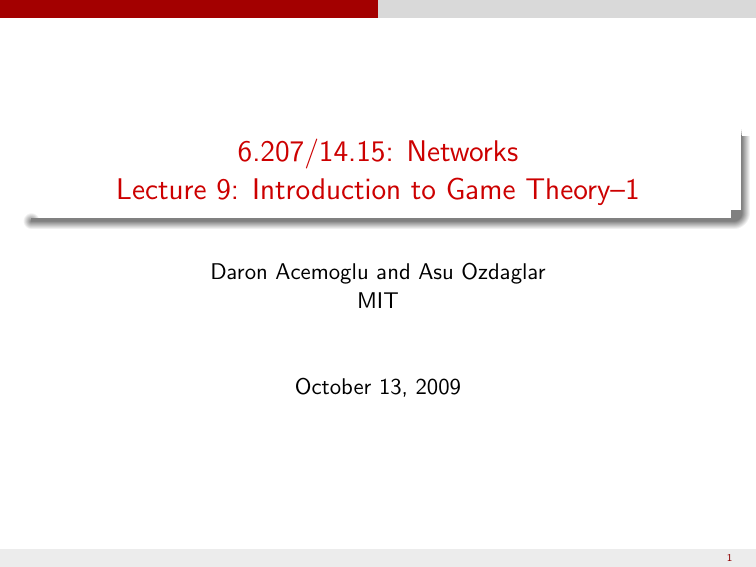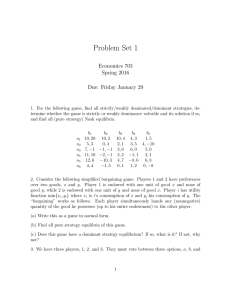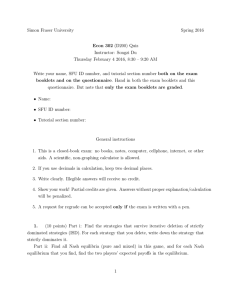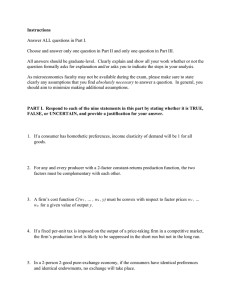Document 13572821
advertisement

6.207/14.15: Networks
Lecture 9: Introduction to Game Theory–1
Daron Acemoglu and Asu Ozdaglar
MIT
October 13, 2009
1
Networks: Lecture 9
Introduction
Outline
Decisions, Utility Maximization
Games and Strategies
Best Responses and Dominant Strategies
Nash Equilibrium
Applications
Next Lecture: Mixed Strategies, Existence of Nash Equilibria, and
Dynamic Games.
Reading:
Osborne, Chapters 1-2.
EK, Chapter 6.
2
Networks: Lecture 9
Introduction
Motivation
In the context of social networks, or even communication networks,
agents make a variety of choices.
For example:
What kind of information to share with others you are connected to.
How to evaluate information obtained from friends, neighbors,
coworkers and media.
Whether to trust and form friendships.
Which of the sellers in your neighborhood to use.
Which websites to visit.
How to map your drive in the morning (or equivalently how to route
your network traffic).
In all of these cases, interactions with other agents you are connected
to affect your payoff, well-being, utility.
How to make decisions in such situations?
→ “multiagent decision theory” or game theory.
3
Networks: Lecture 9
Introduction
“Rational Decision-Making”
Powerful working hypothesis in economics: individuals act rationally
in the sense of choosing the option that gives them higher “payoff”.
Payoff here need not be monetary payoff. Social and psychological
factors influence payoffs and decisions.
Nevertheless, the rational decision-making paradigm is useful because it
provides us with a (testable) theory of economic and social decisions.
We often need only ordinal information; i.e., two options a and b,
and we imagine a (real-valued) utility function u (·) that represents
the ranking of different options, and we simply check whether
u (a) ≥ u (b ) or u (a) ≤ u (b ).
In these cases, if a utility function u (·) represents preferences, so does
any strictly monotonic transformation of u (·).
But in game theory we often need cardinal information because
decisions are made under natural or strategic uncertainty. The theory
of decision-making under uncertainty was originally developed by
John von Neumann and Oskar Morgenstern.
4
Networks: Lecture 9
Introduction
Decision-Making under Uncertainty
von Neumann and Morgenstern posited a number of “reasonable”
axioms that rational decision-making under uncertainty should satisfy.
From these, they derived the expected utility theory.
Under uncertainty, every choice induces a lottery, that is, a probability
distribution over different outcomes.
E.g., one choice would be whether to accept a gamble which pays $10
with probability 1/2 and makes you lose $10 with probability 1/2.
von Neumann and Morgenstern’s expected utility theory shows that
(under their axioms) there exists a utility function (also referred to as
Bernoulli utility function) u (c ), which gives the utility of consequence
(outcome) c.
Then imagine that choice a induces a probability distribution F a (c )
over consequences.
5
Networks: Lecture 9
Introduction
Decision-Making under Uncertainty (continued)
Then the utility of this choice is given by the expected utility
according to the probability distribution F a (c ):
U (a ) =
�
u (c ) dF a (c ) .
In other words, this is the expectation of the utility u (c ), evaluated
according to the probability distribution F a (c ).
More simply, if F a (c ) is a continuous distribution with density f a (c ),
then
�
U (a) = u (c ) f a (c ) dc,
or if it is a discrete distribution where outcome outcome ci has
probability pia (naturally with ∑i pia = 1), then
U (a ) =
∑ pia u (ci ) .
i
6
Networks: Lecture 9
Introduction
Decision-Making under Uncertainty (continued)
Given expected utility theory and our postulate of “rationality,” single
person decision problems are (at least conceptually) simple.
If there are two actions, a and b, inducing probability distributions
F a (c ) and F b (c ), then the individual should choose a over b only if
U (a ) =
�
u (c ) dF a (c ) ≥ U (b ) =
�
u (c ) dF b (c ) .
7
Networks: Lecture 9
Introduction
From Single Person to Multiperson Decision Problems
But in a social situation (or more specifically, in a “social network”
situation), the utility of an agent or probability distribution over
outcomes depends on actions of others.
A simple game of “partnership” represented as a matrix game:
Player 1 \ Player 2 work hard shirk
work hard
(−1, 1)
(2, 2)
shirk
(1, −1)
(0, 0)
Here the first number is the payoff to player (partner) 1 and the
second number is the payoff to player 2. More formally, the cell
indexed by row x and column y contains a pair, (a, b ) where
a = u1 (x, y ) and b = u2 (x, y ).
These numbers could be just monetary payoffs, or it could be
inclusive of “social preferences” (the fact that you may be altruistic
towards your partner or angry at him or her).
Should you play “work hard” or “shirk”?
8
Networks: Lecture 9
Introduction
A Paradoxical Network Example
Consider the following “non-atomic” game of traffic routing.
Non-atomic here refers to the fact that there is a “continuum” of
players, so the effect of any given individual on “aggregates” is
negligible.
Each route has a cost (delay/latency) function li (xi ) measuring costs
of delay and congestion on link i as a function of the flow traffic xi on
this link. Suppose that motorists wish to minimize delay.
Traditional Network Optimization Approach: choose the allocation of
traffic so as to achieve some well-defined objective, such as
minimizing aggregate delay.
In practice, routing is “selfish,” each motorist choosing the route that
has the lowest delay.
This problem was first studied by the famous economist Alfred Pigou.
9
Networks: Lecture 9
Introduction
A Paradoxical Network Example (continued)
Consider the following example with a unit mass of traffic to be routed:
delay depends on congestion
1 unit of traffic
no congestion effects
System optimum (minimizing aggregate delay) can be found by solving
min Csystem (x S ) = ∑ li (xiS )xiS .
x1 +x2 ≤1
i
First-order condition:
l1 (x1 ) + x1 l1� (x1 )
2x1
= l2 (1 − x1 ) + (1 − x1 ) l2� (1 − x1 )
= 1
Hence, system optimum is to split traffic equally between two routes, giving:
1 1
3
min Csystem (x S ) = ∑ li (xiS )xiS = + = .
4
2
4
x1 +x2 ≤1
i
10
Networks: Lecture 9
Introduction
A Paradoxical Network Example (continued)
Suppose instead that there is selfish routing so that each motorist
chooses the path with the lowest delay taking aggregate traffic
pattern as given (is this reasonable?).
This will give x1 = 1 and x2 = 0 (since for any x1 < 1,
l1 (x1 ) < 1 = l2 (1 − x1 )). Aggregate delay is
Ceq (x WE ) =
∑ li (xiWE )xiWE
i
3
= 1+0 = 1 > .
4
The outcome is “socially suboptimal”—a very common occurrence in
game theory situations.
Inefficiency sometimes quantified by the measure of Price of
anarchy, defined as
Csystem (x S )
3
= .
WE
4
Ceq (x )
11
Networks: Lecture 9
Strategic Form Games
Strategic Form Games
Let us start with games in which all of the participants act
simultaneously and without knowledge of other players’ actions. Such
games are referred to as strategic form games—or as normal form
games or matrix games.
For each game, we have to define
1
2
3
The set of players.
The strategies.
The payoffs.
More generally, we also have to define the game form, which captures
the order of play (e.g., in chess) and information sets (e.g., in
asymmetric information or incomplete information situations). But in
strategic form games, play is simultaneous, so no need for this
additional information.
12
Networks: Lecture 9
Strategic Form Games
Strategic Form Games (continued)
More formally:
Definition
(Strategic Form Game) A strategic forms game is a triplet
�I , (Si )i ∈I , (ui )i ∈I � such that
I is a finite set of players, i.e., I = {1, . . . , I };
Si is the set of available actions for player i;
si ∈ Si is an action for player i;
ui : S → R is the payoff (utility) function of player i where S = ∏i Si is
the set of all action profiles.
In addition, we use the notation
s−i = [sj ]j �=i : vector of actions for all players except i.
S−i = ∏j �=i Sj is the set of all action profiles for all players except i
(si , s−i ) ∈ S is a strategy profile, or outcome.
13
Networks: Lecture 9
Strategic Form Games
Strategies
In game theory, a strategy is a complete description of how to play
again.
It requires full contingent planning. If instead of playing the game
yourself, you had to delegate the play to a “computer” with no
initiative, then you would have to spell out a full description of how
the game would be played in every contingency.
For example, in chess, this would be an impossible task (though in
some simpler games, it can be done).
Thinking in terms of strategies is important.
But in strategic form games, there is no difference between an action
and a pure strategy, and we will use them interchangeably.
This will no longer be the case even for strategic form games when we
turn to mixed strategies.
14
Networks: Lecture 9
Strategic Form Games
Finite Strategy Spaces
When the strategy space is finite, and the number of players and
actions is small, a game can be represented in matrix form.
Recall that the cell indexed by row x and column y contains a pair,
(a, b ) where a = u1 (x, y ) and b = u2 (x, y ).
Example: Matching Pennies.
Player 1 \ Player 2 heads
tails
heads
(−1, 1) (1, −1)
tails
(1, −1) (−1, 1)
This game represents pure conflict in the sense that one player’s
utility is the negative of the utility of the other player. Thus zero
sum game.
More generally true for strictly competitive games, that is, games in
which whenever one player wins the other one loses, though the sum of
the payoffs need not be equal to 0.
15
Networks: Lecture 9
Strategic Form Games
Infinite Strategy Spaces
Example: Cournot competition.
Two firms producing a homogeneous good for the same market
The action of a player i is a quantity, si ∈ [0, ∞] (amount of good he
produces).
The utility for each player is its total revenue minus its total cost,
ui (s1 , s2 ) = si p (s1 + s2 ) − csi
where p (q ) is the price of the good (as a function of the total
amount), and c is unit cost (same for both firms).
Assume for simplicity that c = 1 and p (q ) = max{0, 2 − q }
Consider the best response correspondence for each of the firms, i.e.,
for each i, the mapping Bi (s−i ) : S−i � Si such that
Bi (s−i ) ∈ arg max ui (si , s−i ).
si ∈Si
Why is this a “correspondence” not a function? When will it be a
function?
16
Networks: Lecture 9
Strategic Form Games
Cournot Competition (continued)
By using the first order optimality
conditions, we have
s2
1
B1(s2)
Bi (s−i )
= arg max(si (2 − si − s−i ) − si )
si ≥ 0
� 1−s
−i
if s−i ≤ 1,
2
=
0
otherwise.
1/2
B2(s1)
1/2
s1
1
The figure illustrates the best response correspondences (which in this case
are functions).
Assuming that players are rational and fully knowledgeable about the
structure of the game and each other’s rationality, what should the
outcome of the game be?
17
Networks: Lecture 9
Dominant Strategies
Dominant Strategies
Example: Prisoner’s Dilemma.
Two people arrested for a crime, placed in separate rooms, and the
authorities are trying to extract a confession.
prisoner 1 / prisoner 2 Confess Don’t confess
Confess
(−2, −2)
(0, −3)
Don’t confess
(−3, 0)
(−1, −1)
What will the outcome of this game be?
Regardless of what the other player does, playing “Confess” is better
for each player.
The action “Confess” strictly dominates the action “Don’t confess”
Prisoner’s dilemma paradigmatic example of a self-interested, rational
behavior not leading to jointly (socially) optimal result.
18
Networks: Lecture 9
Dominant Strategies
Prisoner’s Dilemma and ISP Routing Game
Consider two Internet service providers that need to send traffic to
each other
Assume that the unit cost along a link (edge) is 1
ISP1: s1 t1
ISP2: s2 t2
s1
t2
DC
C
Peering points
t1
s2
This situation can be modeled by the “Prisoner’s Dilemma” payoff
matrix.
ISP 1 / ISP 2 Hot potato Cooperate
Hot potato
(−4, −4) (−1, −5)
Cooperate
(−5, −1) (−2, −2)
19
Networks: Lecture 9
Dominant Strategies
Dominant Strategy Equilibrium
Compelling notion of equilibrium in games would be dominant
strategy equilibrium, where each player plays a dominant strategy.
Definition
(Dominant Strategy) A strategy si ∈ Si is dominant for player i if
ui (si , s−i ) ≥ ui (si� , s−i )
for all si� ∈ Si and for all s−i ∈ S−i .
Definition
(Dominant Strategy Equilibrium) A strategy profile s ∗ is the dominant
strategy equilibrium if for each player i, si∗ is a dominant strategy.
These notions could be defined for strictly dominant strategies as well.
20
Networks: Lecture 9
Dominant Strategies
Dominant and Dominated Strategies
Though compelling, dominant strategy equilibria do not always exist,
for example, as illustrated by the partnership or the matching pennies
games we have seen above.
Nevertheless, in the prisoner’s dilemma game, “confess, confess” is a
dominant strategy equilibrium.
We can also introduce the converse of the notion of dominant
strategy, which will be useful next.
Definition
(Strictly Dominated Strategy) A strategy si ∈ Si is strictly dominated
for player i if there exists some si� ∈ Si such that
ui (si� , s−i ) > ui (si , s−i )
for all s−i ∈ S−i .
21
Networks: Lecture 9
Dominant Strategies
Dominated Strategies
Definition
(Weakly Dominated Strategy) A strategy si ∈ Si is weakly dominated
for player i if there exists some si� ∈ Si such that
ui (si� , s−i ) ≥ ui (si , s−i )
ui (si� , s−i ) > ui (si , s−i )
for all s−i ∈ S−i ,
for some s−i ∈ S−i .
No player should play a strictly dominated strategy
Common knowledge of payoffs and rationality results in iterated
elimination of strictly dominated strategies
22
Networks: Lecture 9
Dominant Strategies
Iterated Elimination of Strictly Dominated Strategies
Example: Iterated Elimination of Strictly Dominated Strategies.
prisoner 1 / prisoner 2
Confess
Don’t confess
Suicide
Confess
(−2, −2)
(0, −3)
(−2, −10)
Don’t confess
(−3, 0)
(−1, −1)
(0, −10)
Suicide
(−10, −2)
(−10, 0)
(−10, −10)
No dominant strategy equilibrium; because of the additional “suicide”
strategy, which is a strictly dominated strategies for both players.
No “rational” player would choose “suicide”. Thus if prisoner 1 is
certain that prisoner 2 is rational, then he can eliminate the latter’s
“suicide” strategy, and likewise for prisoner 2. Thus after one round
of elimination of strictly dominated strategies, we are back to the
prisoner’s dilemma game, which has a dominant strategy equilibrium.
Thus iterated elimination of strictly dominated strategies leads to a
unique outcome, “confess, confess”—thus the game is dominance
solvable.
23
Networks: Lecture 9
Dominant Strategies
Iterated Elimination of Strictly Dominated Strategies
(continued)
More formally, we can follow the following iterative procedure:
Step 0: Define, for each i, Si0 = Si .
Step 1: Define, for each i,
�
�
�
�
0
Si1 = si ∈ Si0 | �si� ∈ Si0 s.t. ui si� , s−i > ui (si , s−i ) ∀ s−i ∈ S−
i .
...
Step k: Define, for each i,
�
�
�
�
k −1
Sik = si ∈ Sik −1 | �si� ∈ Sik −1 s.t. ui si� , s−i > ui (si , s−i ) ∀ s−i ∈ S−
.
i
Step ∞: Define, for each i,
Si∞ = ∩k∞=0 Sik .
24
Networks: Lecture 9
Dominant Strategies
Iterated Elimination of Strictly Dominated Strategies
(continued)
Theorem
Suppose that either (1) each Si is finite, or (2) each ui (si , s−i ) is
continuous and each Si is compact. Then Si∞ (for each i) is nonempty.
Proof for part (1) is trivial.
Proof for part (2) in homework.
But note that Si∞ need not be a singleton.
25
Networks: Lecture 9
Dominant Strategies
How Reasonable is Dominance Solvability
At some level, it seems very compelling. But consider the following
game, often called the k- beauty game.
Each of you will pick an integer between 0 and 100.
The person who was closest to k times the average of the group will
win a prize.
How will you play this game? And why?
26
Networks: Lecture 9
Dominant Strategies
Revisiting Cournot Competition
Apply iterated strict dominance to Cournot model to predict the
outcome
s2
s2
1
1
B1(s2)
B1(s2)
1/2
1/2
B2(s1)
1
/
4
1
/
4
1/2
s1
1
B2(s1)
1
/
4
1
/
4
1/2
1
s1
One round of elimination yields S11 = [0, 1/2], S21 = [0, 1/2]
Second round of elimination yields S11 = [1/4, 1/2], S21 = [1/4, 1/2]
It can be shown that the endpoints of the intervals converge to the
intersection
Most games not solvable by iterated strict dominance, need a
stronger equilibrium notion
27
Networks: Lecture 9
Nash Equilibrium
Pure Strategy Nash Equilibrium
Definition
(Nash equilibrium) A (pure strategy) Nash Equilibrium of a strategic
game �I , (Si )i ∈I , (ui )i ∈I � is a strategy profile s ∗ ∈ S such that for all
i∈I
∗
∗
ui (si∗ , s−
for all si ∈ Si .
i ) ≥ ui (si , s−i )
Why is this a “reasonable” notion?
No player can profitably deviate given the strategies of the other
players. Thus in Nash equilibrium, “best response correspondences
intersect”.
Put differently, the conjectures of the players are consistent: each
∗ , and each
player i chooses si∗ expecting all other players to choose s−
i
player’s conjecture is verified in a Nash equilibrium.
28
Networks: Lecture 9
Nash Equilibrium
Reasoning about Nash Equilibrium
This has a “steady state” type flavor. In fact, two ways of justifying
Nash equilibrium rely on this flavor:
1
2
Introspection: what I do must be consistent with what you will do
given your beliefs about me, which should be consistent with my beliefs
about you,...
Steady state of a learning or evolutionary process.
An alternative justification: Nash equilibrium is self-reinforcing
If player 1 is told about player 2’s strategy, in a Nash equilibrium she
would have no incentive to change her strategy.
29
Networks: Lecture 9
Nash Equilibrium
Role of Conjectures
To illustrate the role of conjectures, let us revisit matching pennies
Player 1 \ Player 2 heads
tails
heads
(−1, 1) (1, −1)
tails
(1, −1) (−1, 1)
Here, player 1 can play heads expecting player 2 to play tails. Player 2
can play tails expecting player 1 to play tails.
But these conjectures are not consistent with each other.
30
Networks: Lecture 9
Nash Equilibrium
Intersection of Best Responses
Recall the best-response correspondence Bi (s−i ) of player i,
Bi (s−i ) ∈ arg max ui (si , s−i ).
si ∈Si
Equivalent characterization: an action profile s ∗ is a Nash
equilibrium if and only if
∗
si∗ ∈ Bi (s−
i)
for all i ∈ I .
Therefore, in Cournot as formulated above, unique Nash equilibrium.
s2
1
B1(s2)
1/2
B2(s1)
1/2
s1
1
31
Networks: Lecture 9
Examples
Example: The Partnership Game
Let us return to the partnership game we started with.
Player 1 \ Player 2 work hard shirk
work hard
(−1, 1)
(2, 2)
shirk
(1, −1)
(0, 0)
There are no dominant or dominated strategies.
Work hard is a best response to work hard and shirk is a best
response shirk for each player.
Therefore, there are two pure strategy Nash equilibria (work hard,
work hard) and (shirk, shirk).
Depending on your conjectures (“expectations”) about your partner,
you can end up in a good or bad outcome.
32
Networks: Lecture 9
Examples
Focal Points
What do we do when there are multiple Nash equilibria?
Our models would not be making a unique prediction.
Two different lines of attack:
Think of set valued predictions—i.e., certain outcomes are possible,
and Nash equilibrium rules out a lot of other outcomes.
Think of equilibrium selection.
Equilibrium selection is hard.
Most important idea, Schelling’s focal point.
Some equilibria are more natural and will be expected.
Schelling’s example: ask the people to meet in New York, without
specifying the place. Most people will go to Grand Central. Meeting
at Grand Central, as opposed to meeting at any one of thousands of
similar places, is a “focal point”.
33
Networks: Lecture 9
Examples
Examples: Battle of the Sexes and Matching Pennies
Example: Battle of the Sexes (players wish to coordinate but have
conflicting interests)
Player 1 \ Player 2 ballet football
ballet
(1, 4) (0, 0)
football
(0, 0) (4, 1)
Two Nash equilibria, (Ballet, Ballet) and (Soccer, Soccer).
Example: Matching Pennies.
Player 1 \ Player 2 heads
tails
heads
(−1, 1) (1, −1)
tails
(1, −1) (−1, 1)
No pure Nash equilibrium (but we will see in the next lecture that
there exists a unique mixed strategy equilibrium).
34
Networks: Lecture 9
Examples
Examples: Cournot Competition
We now provide an explicit characterization of the Nash equilibrium
of Cournot for a specific demand function.
Suppose that both firms have marginal cost c and the inverse demand
function is given by P (Q ) = α − βQ, where Q = q1 + q2 , where
α > c. Then player i will maximize:
max π i (q1 , q2 ) = [P (Q ) − c ] qi
qi ≥ 0
= [α − β (q1 + q2 ) − c ] qi .
To find the best response of firm i we just maximize this with respect
to qi , which gives first-order condition
[α − c − β (q1 + q2 )] − βqi = 0.
Therefore, the best response correspondence (function) or firm i can
be written as
α − c − βq−i
qi =
.
2β
35
Networks: Lecture 9
Examples
Cournot Competition (continued)
Now combining the two best response functions, we find the unique
Cournot equilibrium as
q1∗ = q2∗ =
α−c
.
3β
Total quantity is 2 (α − c ) /3β, and thus the equilibrium price is
P∗ =
α + 2c
.
3
It can be verified that if the two firms colluded, then they could
increase joint profits by reducing total quantity to (α − c ) /2β and
increasing price to (α + c ) /2.
36
MIT OpenCourseWare
http://ocw.mit.edu
14.15J / 6.207J Networks
Fall 2009
For information about citing these materials or our Terms of Use,visit: http://ocw.mit.edu/terms.









